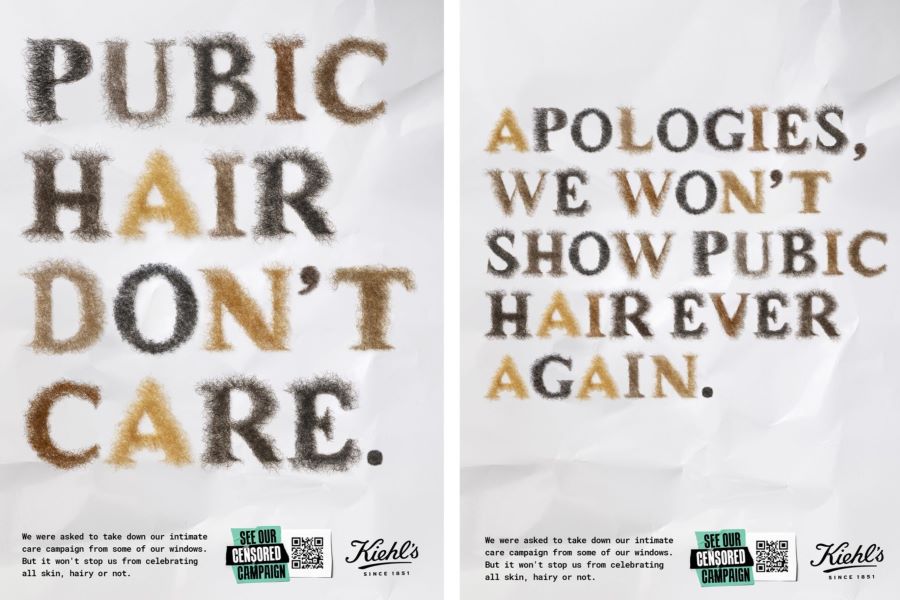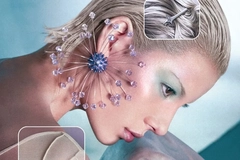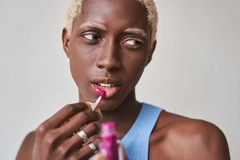“Pubic hair don’t care”: Kiehl’s reiterates body acceptance after censorship on previous campaign

Kiehl’s has crafted advertisements introducing the font Pubic Display Type, made entirely from human pubic hair, after some store windows censored its intimate care line campaign showing models with pubic hair.
Kiehl’s entered the intimate care category with the launch of its Personals collection last August. As part of this launch, Kiehl’s unveiled a campaign showcasing imagery of models with visible pubic hair to “challenge conventional beauty standards.”
However, some visuals were censored, leading Kiehl’s to double down and use the censorship as an opportunity to amplify its message. It calls its Pubic Display Type “a creative response to censorship and an unapologetic celebration of self-care for all skin, including intimate areas.”
Kiehl’s Global brand president, Jon Sáenz, says: “Our response to the censorship of our Kiehl’s Personals imagery underscores our commitment to honest conversations about body hair and our private parts and challenging outdated societal taboos. Pubic hair is a natural part of the human body, and there is no reason to feel uncomfortable with it. We believe in providing solutions for all skin care needs, without exception.”
Ceasing censorship
According to Kiehl’s, conversations around the word “pubic” are traditionally negative, and Gen Z wants to change that. Period brand Bodyform reports that 46% of people in the US feel there’s a stigma attached to using medical terminology when describing anatomy, and only 20% are comfortable discussing their bodies.
 Gen Z has expressed interest in more beauty ads showing body hair. Backing this movement, Innova Market Insights named “Blurring the Gender Lines,” a global beauty trend, highlighting weakening gender-based barriers. Some 53% of consumers globally think that beauty products should be gender-neutral, so new beauty product launches feature this positioning.
Gen Z has expressed interest in more beauty ads showing body hair. Backing this movement, Innova Market Insights named “Blurring the Gender Lines,” a global beauty trend, highlighting weakening gender-based barriers. Some 53% of consumers globally think that beauty products should be gender-neutral, so new beauty product launches feature this positioning.
The “Blurring the Gender Lines” trend underscores the personal care industry’s commitment to reflecting diverse identities and fostering an inclusive beauty landscape.
Kiehl’s campaign features plain white backgrounds with a series of statements written in the Pubic Display Type. The longest poster reads: “Our photos of models with pubic hair were censored, so we removed the models.” The other two are shorter and quippy: “Pubic hair don’t care,” and “Apologies, we won’t show pubic hair ever again.” The imagery was shared across the brand’s digital platforms.
The skin care brand says it “stands by the idea that every skin deserves care and respect — from head to toe, and everywhere in between.”
Showing off body hair
Last year, Dove launched a #FreeThePits campaign to encourage women to reject underarm stereotypes and embrace their armpits inspired by the Dove Underarm Confidence Survey in 2022.
The research found that 80% of female respondents believe society promotes an “ideal” underarm. Most say the “ideal” underarm should be hairless, smooth, odorless and even-toned. Eighty-two percent of women feel embarrassed by their underarms.
To combat this optimal armpit standard, Dove showcased a multitude of women’s armpits “whether they’re light or dark, bumpy or smooth, stubbly or in full bloom” across New York City, US, during its fashion week.












